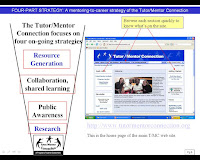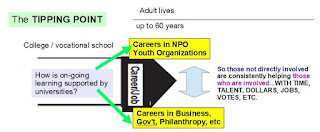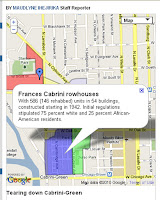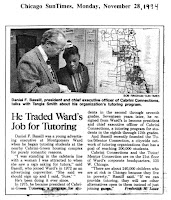Every year about this time between 1990 and 2010 I was writing grant requests, hosting site visits, and writing final reports to gain the operating dollars needed to support the annual activities of the site based tutor/mentor program I led in Chicago called, Cabrini Connections, and the Tutor/Mentor Connection, which I now lead through Tutor/Mentor Institute, LLC.
It’s amazing how many people assume that getting teens and volunteers to Cabrini Connections each week was a simple process, and wanted to focus on how many kids are now college graduates because of the $5,000 to $25,000 they have provided in the past year.
In October 2008 I thought I’d write and article to reflect on this. That article is posted below, with some updates. I called it “
Below the Ice” because when you see an Iceberg, all you see is what’s above water. Most of it is below water and out of site. When you see a student and volunteer meeting at Cabrini Connections on a Tuesday or Wednesday evening, you'd you see what was happening for these two hours. You wouldn't see the infrastructure and program support it takes for the student and volunteer, or Cabrini Connections, to simply be here to make this connection.
So, what are we not seeing, or taking for granted? This is a long article. In the first section I write about the thinking that goes on to make a program like this available to kids and volunteers.
In the second section is a list of elements that must be in place to support this process.
a) Someone had to make a commitment to start this organization, and keep it going. Cabrini Connections was not created by some government initiative, with a bundle of up-front dollars. It was started in October 1992 by seven volunteers who saw a need. They created Cabrini Connections to provide a 7th grade through high school support system for kids who were aging out of the 2nd to 6th grade Montgomery Ward/Cabrini Green Tutoring Program. They had no money. They had no space to operate. During the spring of 1993 there was no paid staff, and volunteers and kids met each week in the day-room of St. Joseph’s Church on Orleans Street in Chicago, and once a week at Wells high school.
b) Space is needed. We operated from the dayroom of a church for the first six months of 1993. Then the Montgomery Ward Corporation donated an entire floor of their corporate tower (almost 20,000 sq. ft. of space), along with desks, cabinets, parking and security. We operated from there from August 1993 until June 1999. Then we moved to rented space as Wards went out of business. We actually spit into two buildings, 8 blocks apart. The Cabrini Connections program operated at Holy Family Church on Larrabee, while the T/MC, and Fund Raising, operated from a room at 1111 N. Wells. In 2001 we moved into our current 4,000 sq ft location at 800 W. Huron, just a few blocks from Cabrini Green.
While we had donated space we could devote all funds raised to our programs. And we had a $40,000 annual grant from Wards. This really helped us get off the ground because in 1993 we only raised $50,000 and in 1994 we only raised $114,000. Without the help from Wards the program would never have built any kind of following. However, since 1999 space, utilities, and insurance expenses were over $70,000 per year. This was a fixed expense that was necessary for us to continue to offer the program to kids in Cabrini Green. Without funds for the space, insurance, equipment and utilities there is no program.
c) If you want good results, you involved talented people. Volunteers can do tremendous things. I led the tutor/mentor program at Montgomery Ward for 15 years while holding a full time retail advertising job. We had more than 300 kids and 300 volunteers participating by 1990. We had nearly 50 volunteers involved in various leadership roles. Many of these volunteers came from companies beyond Wards. However, to support this type of volunteer involvement I spent my lunch, evening and weekend hours, plus at least one week of vacation each year, doing the work of leading this organization. I had tremendous freedom to take phone calls and work on this during the day, as long as my own work was being done to an outstanding level.
And while we did a great job of keeping kids and volunteers connected, I think we could have done much more if I or another leader had been able to devote 40 to 50 hours a week on this. At Cabrini Connections the glue that keeps the kids and volunteers coming is the lead coordinator, who is a paid staff person. In 2008 we had 70 kids and more than 90 volunteers participating weekly and a more than 400 alumni. We had two full time staff people, one full time e-learning coordinator, and myself. To keep the lead coordinators in place we needed to reward them with decent compensation and benefits, and try to surround them with extra help (staff and volunteers) so they don’t burn out and leave after a couple of years.
d) Volunteers are critical to success of this organization; but they need support, too. We have volunteers in a variety of leadership and organizing roles, not just on the board of directors. Many of them have been involved for five or more years. They represent the organizational knowledge, in addition to my own. However, these lead volunteers need to be recruited, supported and mentored by our lead staff.
e) Volunteers are customers. The need to be recruited. They are not standing in line waiting to be your tutors and mentors. The best way to recruit new volunteers is to provide a great experience for your current volunteers. We started with seven volunteers in October 1992 and added new volunteers each school year from 1993 till I wrote this in 2008. We grew Cabrini Connections, and before that the Montgomery Ward/Cabrini Green Tutoring Program, by converting volunteers into ambassadors who go out and recruit other volunteers. Many of these people are also recruiting the dollars we need. However, this is not something that happens by accident. It takes lots of time, and a consistent effort to provide a well-organized experience, and to mentor volunteers as they attempt to build relationships with kids. It takes a constant external communications (see below) to attract new volunteers to replace those who leave the program during every year.
f) Kids are volunteers, too. This is not a court mandated program, or a program for failing kids who are sent here by schools. We focus on kids who can succeed in school and life if they just get the support the need to overcome the obstacles poverty put in their lives. These kids did not start Cabrini Connections. Our founders saw a need and invited kids to participate. Each year our customer service intends to provide an experience that motivates kids to come back each week, and each year. Each year our outreach aims to recruit new students who don’t know about our program, but might participate if given the chance.
g) Our volunteers are the CEOs of this effort, not the staff. Each volunteer is different and each youth is different. The strength of a one-on-one program is the ability of a volunteer to tailor his/her mentoring and tutoring to the needs of the student and the talents and time available from the volunteer. The longer someone stays involved, the more experienced and effective they become. And while 25% of our volunteers will stay 3 or more years, many only stay one year, and some do not complete their first year. This means the volunteer work force is in constant need of mentoring and coaching from other volunteers and from experienced staff.
h) Finding space, finding staff, setting up a structure and a recruitment campaign to get kids and volunteers to participate is just the beginning. Each week during the school year there is constant follow up and coaching of each student/mentor pair. There is constant planning to develop activities to support the weekly tutor/mentor sessions. There are mountains of details required to track attendance, keep information current in databases and on email lists, and to stay in touch with parents, teachers, social workers, as well as volunteers. There are new volunteers to be interviewed. There are 70 kids, and 70 different sets of personal and family issues to deal with each week.
i) Communications is hard work and takes time. Creating the training materials, writing the weekly email newsletter, maintaining the web site and on-line documentation systems, and creating brochures to recruit new students and volunteers requires time and talent. The less talent you have at writing, the longer it takes to write a letter, or a brochure. We are required to multi-task because we only have 3 people. Yet, if we do not provide these communications, we cannot mentor and guild the process of our kids and volunteers.
j) Does it work? We say kids and volunteers vote with their feet. Thus, if they come most of the time (80% is our goal), and most return from one year to the next (kids goal: 80% return; volunteer goal: 65% return) then we feel they are telling us that they like what we are doing. However, donors want to know more. What impact does this have on grades, test scores, social and emotional behavior. We can say from observation and feedback that it benefits some kids more than others and that some volunteers have had life changing experiences because of their involvement. That’s enough to keep me working on this every day.
However, we can’t quantify this via traditional research and evaluation. Why? We barely have the manpower to do what we’re doing. That’s why. Furthermore, the impacts of this type of mentoring are long term. The benefits accumulate over time. An evaluation would need to cover many years and extend into the years after kids have finished high school to paint a true picture of our impact. Such research is not being done in very many places because most programs have the same problem we have of not being able to stay connected to kids or volunteers once they no longer attend the program.
(visit my page on Facebook and look at my friends list. Many are alumni. If you look at the posts on their own timelines you'll see stories of their success, and the success of their own children who are now finishing high school and entering college.)
k) The money does not come out of thin air. It took six months to find donated space at Montgomery Ward, along with a $40,000 grant, that enabled the program to hire part time staff, and purchase needed office equipment. Every year since then, the organization has started the new fiscal year (Jan. 1) needing to raise all of the money for the program’s operations (rent, utilities, insurance, staff, etc.) as they also provided coaching to kids and volunteers. During the 10/7/08 Presidential campaign debate one question asked was “what level of sacrifice will you ask from Americans”. I don’t think either candidate answered that question. If you read my blog I think that for there to be programs like Cabrini Connections in hundreds of places, lots of people are going to need to go beyond 2% annual donations, and a few hours of volunteering. Our men and women in the armed forces give 100% for our freedoms. Each person needs their own personal barometer, but hopefully our leaders can light a fire so some people will go beyond the call of duty for citizen service.
l) And we cannot attract donors without good communications and consistent outreach and evidence of impact. Many larger non profits have full time development directors and staffs with many people. They can farm out creative work to ad agencies and creative services because they have the money to do that. One potential donor, who was worth about $500 million, once asked me why I needed to spend $70,000 a year on fund raising. He said his charity did not need to do that. He could just call someone and get the money they need. He gave me $1,000 one year and nothing after that. My budget for Cabrini Connections was about $200,000 in 2008. How did he think we were finding the other $199,000? If we’re spending all of our time coaching kids and volunteers, where do we find time to market and do fund raising?
m) The answer would be to have people with high net worth adopt Cabrini Connections. Then they could call themselves up each year and say how much good work we are doing, and ask for a donation to cover the budget. A CEO of a real estate company once said “that’s a tax deduction” when talking about the $4 million it would take to purchase a building for our operations.
n) Another answer would be to build a network of 1000 people with modest means who would each provide $250 per year to support the program. That has more potential. $250 is really just $5 a week, or, maybe the cost of one latte at Starbucks each week. Is the potential future of an at-risk child worth a cup of java to you?
What Basic Conditions need to be met, to attract students and volunteers to a site based tutor/mentor program?
Listed in order of priority are the organizational needs that had to be met each week for CABRINI CONNECTIONS to maintain the high quality level for which it has earned a reputation of excellence.
1) Create positive environment for tutors and students to spend time together.
• Clean, orderly area (70 desks, 100 chairs)
• Pencils, paper, calculators, scissors, attendance lists, and other needed supplies stocked in cabinets
• Learning resources, such as library, worksheet binders, and geography materials in place and orderly.
• Coffee and snacks in stock and prepared for distribution.
2) Provide a structure and support that offers an opportunity for a satisfactory experience. Focus primarily on tutors because if volunteers were to stop coming, the program would not survive.
• Annual evaluation, review and plan which incrementally builds on previous year accomplishments
• Regular communications program (newsletters, email, blogs, web sites, bulletin boards, etc.)
• Informational and historical record (Annual Report, brochures, etc.)
• Information on community resources, field trip activities, etc.
• Motivation activities such as parties, field trips, and writing contests
3) Provide a broad base of resources from which individual children and tutors can build activities.
• Library, with reference materials and motivational activity worksheets
• Internet Library with home work help, suggested activities, tips for tutors/mentors, networking opportunities.
• Student history file with report cards
• Teacher referral forms from local schools
• School supplies, learning resources, library
• Computers, with dedicated work area
• Speaker/Role Model Program
• Field Trips to business and college sites
• Parties and informal social gatherings for kids and volunteers
4) Ensure frequency and consistency of participation. Focus on student attendance because if students come inconsistently tutors will eventually stop coming. Focus on tutor attendance to improve relationships and quality of tutoring/mentoring children receive.
• Preparation of weekly attendance record, with volunteers to do check in
• Maintenance of tutor and student address data-base with up-to-date info
• Tutor contact network with weekly follow-up
• Weekly calls and letters to children with 2+ absences
• Perfect attendance recognition and reward for 10 weeks without absence
• Recognition for volunteers with 90% or better attendance
• Marketing and maintenance of Point Bank system
5) Provide training and other motivational resources to enable tutors to have more satisfying and effective experience.
• Written Handbook, plus regular handouts
• Organized training sessions (Orientation, Fall Workshop, Jan. Workshop)
• First Year tutor orientations every 6 weeks
• Encourage participation in program committees and after-tutor activities
• Files full of math and language-skills worksheets, to be used as individual lessons
• SVHAT20 on-line support system for students and volunteers
6) Provide direct service benefits to children.
• Safe environment in which to interact with caring adult.
• Role models to spend time with
• Extra learning activities such as arts, technology, writing clubs
• Computer and Internet access for homework help, networking, communications with volunteer
• Learning materials (books, pencils, reference books, dictionaries, etc.)
• Books to check out and take home to read.
• Snacks at sessions
• Experience and enrichment activities (field trips, etc.)
• Parties, with gifts and treats
7) Involve parents in tutoring activities and children’s education.
• Parent Orientation at start of year
• Involvement of parents in weekly sessions
• Informational literature provided through program
• Auxiliary parent-education programs on subjects such as nutrition, or reading to children at home
8) Involve teachers and social workers in tutoring activities and children’s education.
• Teacher and Social Worker Orientation or Introduction at start of year
• Involvement of teachers and social workers in developing mentoring and tutoring strategies
• Informational literature provided through program
• Report Card permission from parent so school can release information directly to program
• Coach volunteer to contact teacher or social worker directly
9) Involve business in tutoring and mentoring activities and children’s education.
• Through the
Success Steps engage business in providing training programs to prepare students for work
• Create a pool of part-time and summer jobs for qualified students, at companies which commit to also “mentor” students while on the job
• Create scholarship pools from Success Steps companies which help student obtain advanced education.
• Invite businesses to Career Day activities
• Teach volunteers to be ambassadors for tutor/mentor within their company or industry
The leaders of Cabrini Connections needed to be thinking about all of the things listed above, every day, every year. Finding people who understand this, and can recruit volunteers and donors to help do some of the work, and who can relate to kids and families, and who will stay with this five or ten years, is the biggest challenge we faced.
We can overcome part of this challenge if we can find donors who understand what's under the surface and who will help us have the operating dollars to try to make this type of program available to teens in this part of Chicago.
If you've read this far, thank you. I led this process every year from 1975 until mid 2011 (as a volunteer from 1975 till 1990). The original program I led is now
Tutoring Chicago. Cabrini Connections became
Chicago Tutoring Connection around 2013. Sadly, they stopped operating around 2023. They and each other youth tutor/mentor program in the Chicago area need your contributions this year, and every year.
If you lead a non-school youth program, what are the elements that make your volunteer-based tutor/mentor program a success. Do you share this on your web site so others can learn from you?
What I described above only showed work we did weekly to operate our youth-serving tutor/mentor program. At the same time we were working to make our program successful, we were trying to help
more than 100 similar programs located in different parts of Chicago get the ideas and resources each of them also needed. And we were trying to build and share a library of information that our volunteers and leaders could use, as well as leaders from other programs.
We were doing that with no more than 2 full time staff.
I only am responsible for the Tutor/Mentor Connection now, via
Tutor/Mentor Institute, LLC. This blog is one of the resources I use to share information others can use. While I no longer lead a direct service program I share my 35 years of experience in posts like this to help other programs grow throughout Chicago and in other cities and states.
Feel free to borrow and share the ideas. If you'd like to connect I'm on Twitter, Facebook, Instagram and LinkedIn.
If you'd like to help, see my
FundTMI page, or my
75th Birthday page.































































